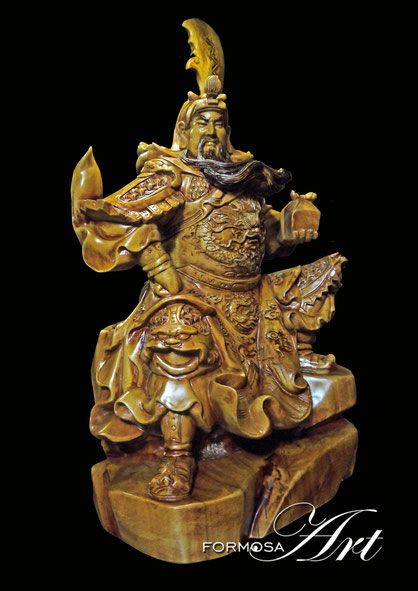- Home
- Custom-Made Luopan
- How to order
- Feng Shui Luopan
- Stephen Skinner's Luopan
- Sherry Merchant's Luopan
- Joseph Yu's Luopan
- Howard Choy's Luopan
- P. Ros' Luopan
- CLASSY Luopan Page 1
- CLASSY Luopan Page 2
- CLASSY Luopan Page 3
- PREMIUM Luopan
- Aluminum Luopan
- IMPERIAL Luopan
- San Yuan Luopan
- San He Luopan
- Zong He Luopan
- Xuan Kong Luopan
- Luopan Remedy
- What is Poly
- What is Red Gloss Lacquer
- Feng Shui Accessories
- Feng Shui Webinars
- Feng Shui Books
- Feng Shui Knowledge
- About us
- Partner Sites
Feng Shui Blog - Juergen Mueller Page 2

June 27, 2015
Daoism God and Feng Shui
by Juergen Mueller

Guan Gong
The General and God
Guān Yǔ (trad. Chinese 關羽 ) * 160; † 220 AD), was a general serving under the warlord Liu Bei in the late Eastern Han dynasty. He played a significant role in the civil war that led to the collapse of the dynasty and the establishment of the state of Shu Han, founded by Liu Bei, in the Three Kingdoms period. As one of the best known Chinese historical figures throughout East Asia, Guan's true life stories have largely given way to fictionalized ones, most of which are found in the historical novel Romance of the Three Kingdoms or passed down the generations, in which his deeds and moral qualities have been lionized. Guan is respected as an epitome of loyalty and righteousness.
There are no descriptions in the historical records of Guan Yu’s physical appearance, but his beard was mentioned in the Sanguozhi. Traditionally, he is portrayed as a red-faced warrior with a long lush beard. The idea of his red face may have derived from a description of him in the first chapter of the Ming dynasty historical novel Romance of the Three Kingdoms, where the following passage appears:
Xuande took a glance at the man, who stood at a height of nine chi, (2 m) and had a two chi long beard (0.46 m); his face was of the color of a zao, (dark red hue, like the color of dark jujube fruit ) with red lips; his eyes were like that of a phoenix's, (The corners of his eyes were upturned) and his eyebrows resembled silkworms (They were long and tapered).
He had a dignified aura and looked quite majestic.
Supposedly, Guan Yu's weapon was a Guan Dao named Green Dragon Crescent Blade, which resembled a glaive and was said to weigh 82 catties (about 18.25 kg). A wooden replica can be found today in the Emperor Guan Temple in Xiezhou County, Shanxi.

Guan Dao
Guan Yu was deified as early as the Sui dynasty (581-618 AD) and is still worshipped by many Chinese people today, especially in southern China, Taiwan, Hong Kong, and among many overseas Chinese communities. He is a figure in Chinese folk religion, popular Confucianism, Taoism, and Chinese Buddhism (Sangharama Bodhisattva, trad. Chinese 伽藍菩薩), and small shrines to Guan are almost ubiquitous in traditional Chinese shops and restaurants.
He is often reverently called Guan Gong (Lord Guan) and Guan Di (Emperor Guan).
Guan Gong and Feng Shui
Guan Gong is Chinese God of War and known for being very powerful. He is believed to provide people who invite him into their home or at work with both status and protection. Businessmen looking for power or to be treated equally typically seek his help. So, became also God of Business.
Here are some placements and Feng Shui recommendations on how to use Guan Gong sculptures:
- Facing Entranceway: It is believed that a Guan Gong will protect against fraud and embezzlements. This is believed to strengthen business relationships and build loyalty and trust among workers.
- Facing the main entrance: It is believed that Guan Gong will help to keep out any visitors to your home who have negative or ill intentions. He will guard your establishment from embezzlement and con. In addition to this, he will eliminate malignant chi and protect from competitors, providing your establishment with the chance to flourish and obtain monetary gain.
- Northwest: By placing the Guan Gong sculpture here, you will be protected against lies and betrayal. This is recommended for businessmen, or business women who are in a position of power. This placement will attract luck with a mentor, specifically of the adored Gui Ren. This type of luck will bring you a good samaritan or someone kind and helpful who will give you a lending hand or a life-changing push during times of distress, trouble and difficulty; not necessarily in the form of money but also opportunities, wise advice, support, encouragement or simply be there to listen. Doing so will also ensure unity and calm for the family to function, as well as protect the patriarch from any harm.
Note: Never place a Guan Gong sculpture in the bathroom, bedroom or yin energy space; he must be in a place of respect. However, praying to him is not required.
There are two kinds of sculptures, one is holding the guan dao (sword), ready to fight
and the other sculptures have the guan dao standing in the back. For homes it is recommended to use the second one, this also ensures there is peace and harmony for everyone in the home as well as protection for the Father (Patriarch).
Businessmen can use either one. Guan Gong sculptures are ideal for individuals in quest of authority in politics and office status.
In the office, simply place his image or sculpture behind the desk or work area (optimum for those with immense power, such as managers, executives and politicians).
Doing so will keep you guarded, preventing any betrayal or backstabbing.











